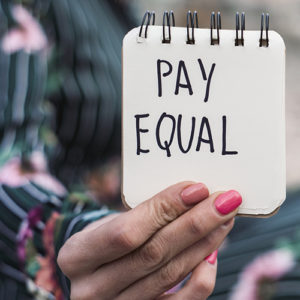The Diane B. Allen Equal Pay Act, which became effective July 1, 2018, significantly amended the New Jersey Law Against Discrimination (LAD) to strengthen protections against employment discrimination. It addresses equal pay for women and other protected categories.
Much focus has been given in the past couple of years to widespread practices of discriminatory pay gaps among workers, and the New Jersey employment law now offers protections for workers. An employer may not pay any member of a protected class less than the rate paid to employees (who are not members of that protected class) for “substantially similar work when viewed as a composite of skill, effort and responsibility.”
For small to mid-sized businesses and Community Associations, those seemingly huge “wins” in salary negotiation might now be considered a substantial liability if consistent discrimination is the inadvertent outcome.
What defines “a protected class”?
Membership in a protected class includes race, creed, color, national origin, ancestry, age, marital status, civil union status, domestic partnership status, affectional or sexual orientation, genetic information, pregnancy or breastfeeding, sex, gender identity or expression, disability or atypical hereditary cellular or blood trait of any individual, or liability for service in the armed forces.
What exceptions exist to The Diane B. Allen Equal Pay Act?
While there are few exceptions to the Diane B. Allen Equal Pay Act, here are a couple for consideration. Keep in mind, the burden is on the employer to prove the exception. The employer must be able to demonstrate the following:
- Pay differential is due to a seniority or merit-based system;
- Pay differential is based on one or more legitimate, bona fide factors other than the characteristics of members of the protected class, such as training, education or experience, or the quantity or quality of production;
- Pay differential is not based on, and does not perpetuate, differences in compensation based on gender or any other characteristic of members of a protected class;
- That each of the factors is applied reasonably;
- That one or more of the factors account for the entire wage differential; and
- That the factors are job-related with respect to the position in question and based on a legitimate business necessity.
For many small- to medium-sized businesses and Community Associations, conducting a professional pay equity study is absolutely necessary to manage the risks of compliance. Employee privacy is essential.
Conducting a pay equity study
Pay equity studies begin by comparing the pay of “similarly situated” employees – exemplifying the “equal pay for equal work.” But today’s rules for who is comparable are not the same as they were historically. Today, pay encompasses hiring rate, plus all subsequent changes in pay, including those that result from a promotion or transfer. This can turn into a forensics exercise, as employees who do similar work today may have previously worked in wildly different roles. This historical pay information is needed to understand pay differences (although it may not necessarily qualify as justification for disparity).
Legitimate reasons for pay differences can include differences in knowledge, skill, ability, effort or responsibility. Care should be given as to how these baseline differences are measured and documented. Often pay equity studies will utilize the following descriptors to explain pay disparities: communication skills, education, emotional demands, initiative, knowledge, length of time in job or grade, management responsibility, mental skills, physical demands, physical/geographic location, and prior experience.
Additional information that is collected and analyzed through a pay equity study includes:
- work activities
- human behavior
- skilled or unskilled use of machines, tools, equipment and other work aids
- job context, and
- human requirements.
The ongoing foundation for equal pay
An equal pay foundation can be challenging for Community Associations and other organizations where volunteers and/or a management company have shared responsibility. We like to focus on:
- Transparency
- Elimination of bias
- Addressing existing occurrences of pay discrimination
Transparency
Crafting accurate and comparable job descriptions makes it much easier to benchmark and evaluate different jobs — to help ensure that employees doing equal work receive equal pay. This is now the foundation for a transparent, equitable pay system. The pay equity analysis should include salary guides for all positions.
Elimination of Bias
Too often, historic job descriptions and job titles are riddled with inadvertent bias that may ultimately lead to discrimination. Job titles were often used to indicate jobs performed by men versus women, even when the same work is essentially performed.
Addressing Existing Occurrences of Pay Discrimination
While the new salary guides can help manage the compensation of new employees and establish appropriate pay increases for existing employees, instances may arise where an individual falls within a the parameters of pay discrimination. How you handle this issue is of critical importance (and the reason why your employment law attorney is essential to the discussion). Whether managed by the community association volunteer board or by a property management firm, negotiating instances of pay discrimination may have broad ramifications for all parties.
Your company or organization might hold a meeting specifically to discuss these matters and set a timeline for actionable goals. An attorney can help facilitate this discussion and to highlight areas of potential risk. This is an ongoing discussion, and your participation is a positive step. With systems in place, compliance can get easier and become a more natural process. By engaging everyone in the process, the company demonstrates good faith and its intention to comply with the law.
